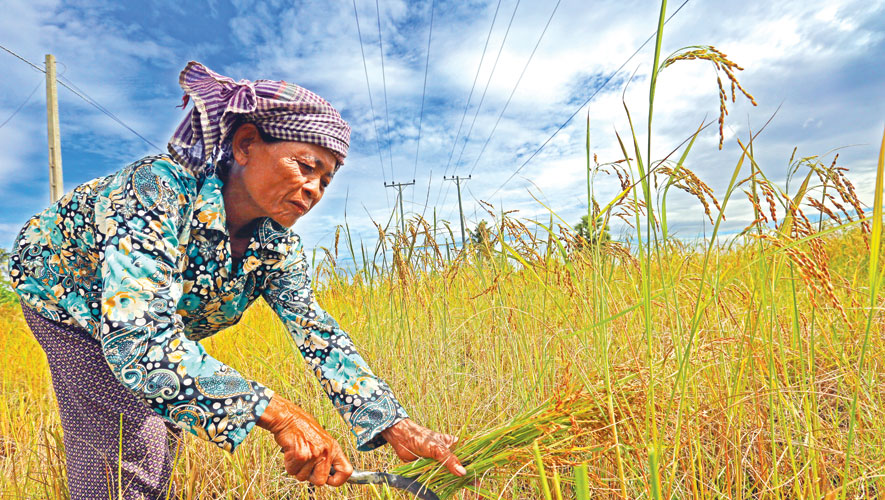Solo insurer chugs on to help more farmers despite making losses itself
For the latest Cambodian Business news, visit Khmer Times Business
The call for crop insurance has been around for more than a year now but Cambodian farmers remain skeptical over its benefit, and the thought of paying a high premium.
Government officials claim that it is tool to protect farmers from losing their investment in the event of natural disasters but the idea has yet catch up on the ground.
Crop insurance is a very new concept among farmers in Cambodia. It is a risk mitigation tool that can fully or partially cover the losses of agricultural output caused by natural disasters such as drought and floods.
About three million rice farmers make up 19 percent of the Cambodian population. They own or lease some 2.91 million hectares of rice fields.Like any agricultural venture, much of the yield is dependent on the weather, and rice planting is no exception. This makes this sector vulnerable to climatic conditions.
From April to May this year, temperatures are expected to soar to 42 degrees Celcius resulting in a prolonged drought, and thunderstorms with strong winds brought upon by El Nino.United Nations Development Programme puts drought-related potential harvest loss at more than 80 percent for one rice-producing season.
Here is where crop insurance comes in to stop farmers from losing sleep over reduced output or crop damage that can result in a temporary loss of livelihood.
Pakk Yourng, managing director of Agribuddy tells Capital Cambodia that crop insurance could help farmers reduce the risk of losing their production cost. He says farmers also need not take out additional loans to cover losses as they will be covered by the insurance.
Agribuddy works with some 7,000 farmers in Kampong Thom, Siem Reap, Banteay Meanchey, Battambang, Pailin and Pursat with Forte Micro Insurance (FMI) last year. As this type of insurance is relatively new, it takes time for insurers and stakeholders to educate and build trust among the farmers. Pakk also feels that raising market awareness on crop insurance can only work if corporate partners sell it at an affordable rate and make it a compulsory product.
Presently, only FMI which is part of Forte Insurance (Cambodia) Ltd, is offering the product to farmers here. The scheme was introduced in 2015 as a pilot project with 60 hectares of rice fields insured. Last year, 150 hectares of paddy land in Pursat, Battambang, Siem Reap and Kampong Thom were insured.
However, despite being the only player in the sector, FMI has yet to post a profit from this venture four years on.
Its data revealed that $10,506 was paid to farmers for an overall crop loss of 150 hectares in 2018 but total premium collected was only $5,232. Farmers in Puok district in Siem Reap province were worst hit by the drought last year, which saw FMI making 100 percent pay out for the farmers’ claims.
“Crop insurances rarely generate profit,” says a general director of FMI who declined being named. “The premium collected annually is never enough to make pay outs but we plan to continue investing in this segment because we want to develop crop insurance in Cambodia,” the director adds.
Each farmer contributes a one-off premium of between $25 and $35 per hectare based on differing levels of risk exposure. The production cost incurred by the farmer for agricultural purposes is $300 to $400 per season. The six months insurance coverage is from May or early June to December every year.
Seeing that climate conditions are going be worse this year, the company plans to insure up to 5,000 hectares of paddy land using a reserve of about $1.7 million, says Forte Insurance managing director Youk Chamroeunrith.
“Although paddy is a high-risk crop and drought is a major concern this year, we are not reluctant to do it. We plan to do more this year and if farmers experience losses, we are happy to cover it. We expect pay outs to range between 20 percent and 100 percent,” he adds.
In the meantime, Forte will expand its small-scale scheme nationwide with help from the government, development partners and relevant stakeholders.
“We will make the scheme more attractive by adding on area yield index which covers multiple risks, not just drought or floods. If there is a yield loss compared to the average yield, it will trigger a pay out,” he says.
Sri Lanka-based LOLC Microfinance finds that crop insurance is not easy to implement in Cambodia as there are transparency issues involving the pay outs.
Its chief executive officer Sok Voeun says it is also difficult to appreciate the impact of drought or floods on the sector.
“What concerns us about the scheme is transparency. The farmer would say the crop is damaged but the insurer might say it is not. So, who will be the judge. This is where we find if difficult (to implement),” Voeun adds.
On the ground though, farmer Chhon Choeuy from Puok says crop insurance saved the livelihood of many farmers in the province.
“Had we not purchased the insurance last year, we would be at a loss. I will definitely take out a policy this year,” he adds.
He spent $35 for one hectare but was able to make a claim of $300 from FMI after his crop was damaged by the drought.




